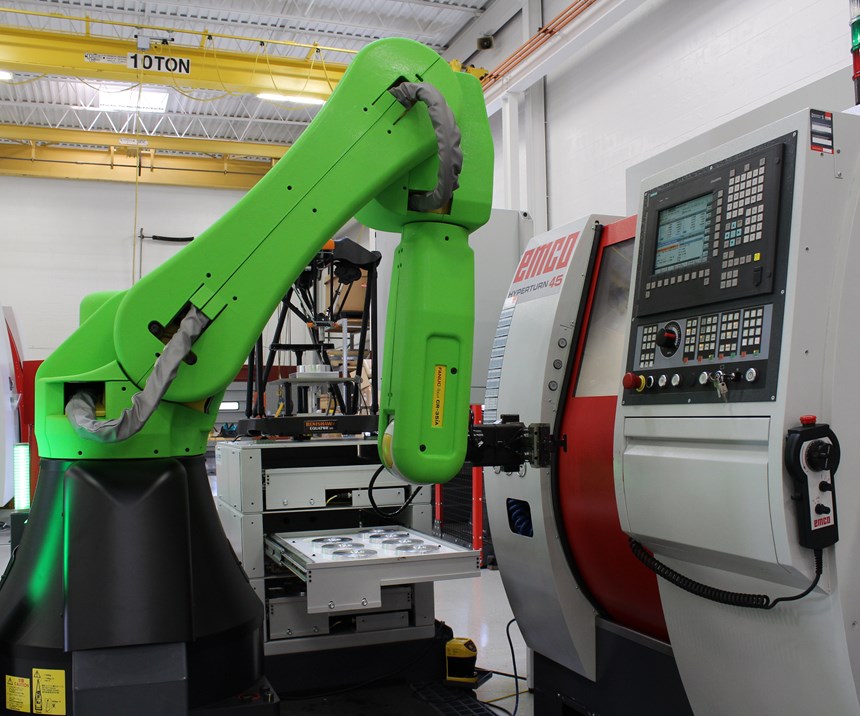Improper Cobot Integration Can Cost $86,000 per Shift Operation
Cobots can improve efficiency, innovation and growth, but companies that buy them without well-defined objectives could be wasting a lot of money.
Manufacturers could be wasting as much as almost $90,000 per year on each operation that requires the use of collaborative robotics due to improper, insufficient or even nonexistent integration of the robots into their processes, says Ultra Tech Automation, an HEH Group company. This estimate, which is based on typical costs for a robot and the number of hours in an industrial shift, is an example of the opportunities lost by not understanding this new industrial mode.
Collaborative robotics have significant opportunity for efficiency, innovation and growth in manufacturing, as long as the collaborative process integration is well-designed and well-implemented. However, the surge in development of these robots has led to a flurry of companies buying them without a well-defined set of objectives or a good plan to use the cobot in their manufacturing processes.
According to estimates by Ultra Tech Automation, an inadequate implementation can cost a manufacturer $86,000 per operation per year, based on the cost of a collaborative robot and the cost of unused time or downtime by employees. This estimate is based on a $100,000 robot with use across a three-shift operation of 2,000 hours per shift per year.
“We see this every day,” says Steve LaMarre, director of automation sales at Ultra Tech Automation. “Our customers seriously invest in these robots—to the tune of anywhere from $40,000 to $100,000--and then let them sit on the floor because they don’t know how to properly utilize them. Money is just flying out the door.”
Manufacturers that do not use their cobots properly lose valuable growth opportunities, including efficiencies, improvements to the line, enhancements to manufacturing quality and other advantages. They also lose opportunities for innovation, which tends to occur “on the shop floor” in response to actual needs and challenges.
Improper use also can limit a manufacturer’s ability to make robotic collaboration work on behalf of its own customers, who in some cases request the purchase of the cobot to begin with. Even manufacturers with in-house engineering capabilities may ultimately not be using the cobots as they should be. Such a situation, for example where the manufacturer and its customer had anticipated process efficiencies or enhancements, can impact shared goals and jeopardize the manufacturer’s own customer relationships.
“So much time and potential for innovation are being wasted due to the availability of these robots and the lack of help in integration,” Mr. LaMarre says. “We see manufacturers demanding the inclusion of cobots be used in processes, but no one is helping them to utilize the robots properly.”
A deep understanding of manufacturing, scope of experience and strategic viewpoint is required to integrate these systems properly. Ultra Tech Machinery has been serving manufacturers for more than 30 years, and its Ultra Tech Automation division was established to provide the skills and resources manufacturers need to ensure that work shared by humans and robots are collaborative, productive and cost effective. With its knowledge and experience in this collaborative robot space, Ultra Tech Automation says it provides a service that can be strategically more significant over time than a traditional engineered solution, which might address a specific function, but not the entire process.
“Because we’ve been working in the collaborative space for some time, we know that every situation is different,” says Bob Hagarty, president of HEH Group. “There can be many different levels of collaboration, true collaboration and limited. With our established resources in manufacturing, machining and technology, we know how to tell if a company is making the most of its robotic collaboration.”
He adds, “These are not frivolous purchases, and manufacturers should not be satisfied with window dressing—too much is riding on the investment they’ve made.”
Different aspects of a company’s manufacturing process may be more suitable to collaborative robots than others. The complexity of industrial functions and process-driven employee activities means that every particular integration should be approached strategically. With hundreds of kinds of robotic functions throughout such areas as industry, defense and engineering services, the very newness of cobots can be a barrier to success in deploying them.
An integration specialist has the resources to serve, support and engineer the robotic technology and the experience to know how best to deploy the robot where it can be used well. This includes helping to integrate the human workers’ functions with those of the robot in effective collaboration.
Related Content
Inside the Premium Machine Shop Making Fasteners
AMPG can’t help but take risks — its management doesn’t know how to run machines. But these risks have enabled it to become a runaway success in its market.
Read MoreUnattended Production Takes More Than the Most Capable CNC Machine
Process planning and reliable peripherals are key to successful lights-out manufacturing.
Read MoreTips for Troubleshooting and Repairing Chip Conveyors
A nonfunctioning chip conveyor can cause a high-production machine to be down for an extended period of time. Here is some troubleshooting advice if you’re having issues with your chip conveyors.
Read MorePursuit of Parts Collector Spearheads New Enterprise
While searching for a small parts accumulator for Swiss-type lathes, this machine shop CEO not only found what he was looking for but also discovered how to become a distributor for the unique product.
Read MoreRead Next
Automated Inspection on the Shop Floor
Most machine shops understand the value of automation when it is applied to such operations as turning, milling and grinding.
Read MoreDo You Have Single Points of Failure?
Plans need to be in place before a catastrophic event occurs.
Read MoreA Tooling Workshop Worth a Visit
Marubeni Citizen-Cincom’s tooling and accessory workshop offers a chance to learn more about ancillary devices that can boost machining efficiency and capability.
Read More












.jpg;maxWidth=300;quality=90)












